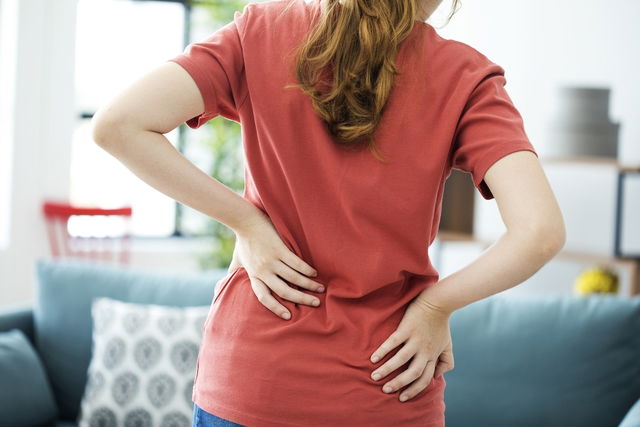Pain in the lower back or the lumbar spine ir normally not serious. It can be the result of bad posture or repetitive activity, for example, which can both be resolved with rest and light massage over the affected area.
Nonetheless, if the pain becomes intense and constant, or if you have other symptoms like pain the legs or glutes, numbness, tingling in the back, shortness of breath, or difficulty moving, then you should see a doctor to assess your symptoms. He or she can confirm a diagnosis and initiate appropriate treatment.
Treatment for lower back pain can be done with the use of muscle relaxants or anti-inflammatories, depending on the type of pain you have. Physiotherapy may also be recommended do strengthen surrounding muscles and relieve symptoms.

The main causes of lower back pain are:
1. Bad posture
Bad posture is one of the most common causes of lower back pain, as sitting with incorrect posture can cause increased pressure on the coccyx, resulting in lower back pain.
How to relieve pain: If your pain is related to bad posture, you should get up throughout the day to stretch and lightly massage the affected area. In addition, you should actively be aware and correct your posture to prevent further pain or the appearance of other problems.
2. Repetitive activity
Performing repetitive activities that involve the lower back, like riding a bike or bending several times throughout the day, can cause muscular and ligament inflammation, leading to pain. In addition, performing exercises which overload the back and also lead result in muscular inflammation in the lower back, causing pain.
How to relieve pain: If your pain is related to repetitive activity, you should rest and, if necessary, take anti-inflammatories (like diclofenac) to relieve your symptoms. Nonetheless, pain that does not resolve with anti-inflammatories should be assessed by your doctor to evaluate the cause.
3. Sciatic nerve inflammation
The sciatic nerve starts at the end of the spine, and when it becomes inflamed or compressed, it can cause intense pain in the lower back as well as pain in the glutes and legs. Sciatic nerve inflammation can also lead to difficulty with straightening your back, bending down, and walking. Learn more about what causes sciatic nerve pain.
How to relieve pain: Once your identify the first signs of sciatic nerve inflammation, you should see your doctor for assessment, so that he or she can formally diagnose your problem and start treatment. Treatment can be done with anti-inflammatories as well as physiotherapy, which can reduce pain, and inflammation, and strengthen the back. You can also consider trying our recommended home remedies and stretching exercises.
4. Herniated disc
A herniated disc occurs when and intervertebral disc sticks out from its space, leading to compression of nerves and pain in the lower back. In addition to feeling lower back pain, you may also experience difficulty walking or bending down, leg weakness and even changes to bladder function, due to compression of local nerves. Learn more about herniated discs and how they can happen.
How to relieve pain: If you suspect you have a herniated disc, you should see your doctor for diagnosis. He or she will evaluate your symptoms and order imaging like X-ray or MRI. In addition, you should also participate in physiotherapy to improve your quality of life.
5. Kidney stones
Kidney stones are characterized by a sharp pain in the lower back, more specifically to the sides. It occurs when kidney stones cause inflammation and obstruct urine flow in the urinary tract. Learn about the most common symptoms of kidney stones and assess your risk for stones with our online quiz.
How to relieve pain: If you experience symptoms of kidney stones, you should see your doctor for assessment to confirm whether kidney stones are present. Appropriate treatment will be decided based on characteristics like the size or shape of the stones. To avoid the formation of kidney stones, it is important to maintain healthy lifestyle habits, like eating a balanced diet, exercising regularly and drinking at least 2 L (12 cups) of water throughout the day.
